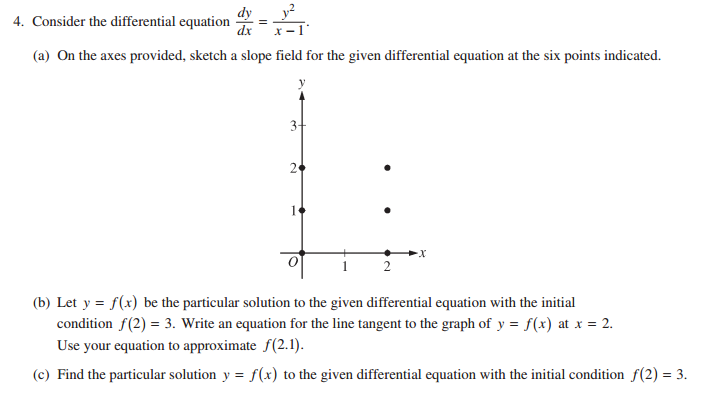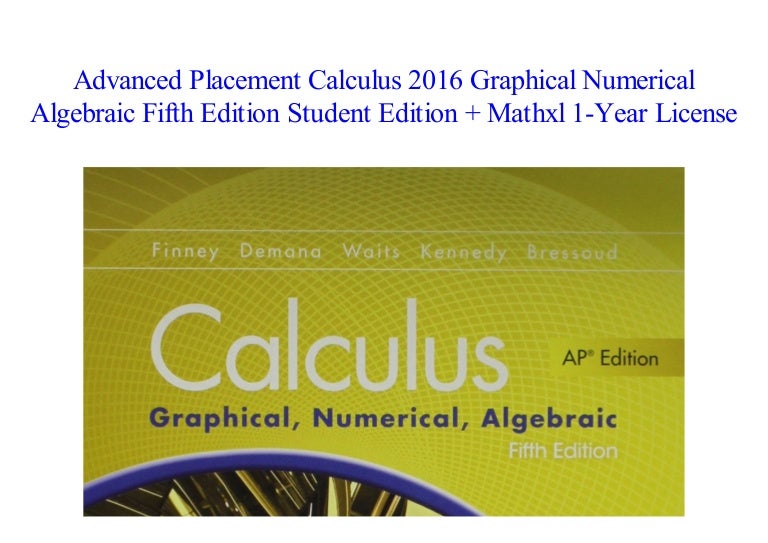AP Calculus Free-Response Solutions and Notes Question AB-1 (a) The left Riemann sum approximation is 50.3 2 14.4 3 6.55 cubic feet. 1 (b) This is an overestimate of the volume of the tank since Ah is decreasing. (c) The volume is 10 0 f hdh 101.325 cubic feet.
| This article is part of a series on |
| Advanced Placement |
|---|
| General exam structure • Awards |
| AP Capstone |
| Current Subjects |
| In Development |
| Former Subjects |
Advanced Placement Calculus (also known as AP Calculus, AP Calc, or simply AB / BC) is a set of two distinct Advanced Placementcalculus courses and exams offered by the American nonprofit organization College Board. AP Calculus AB covers basic introductions to limits, derivatives, and integrals. AP Calculus BC covers all AP Calculus AB topics plus additional topics (including more advanced integration techniques such as integration by parts, Taylor series, parametric equations, vector calculus, polar coordinate functions, and curve interpolations).
- AP ® Calculus AB and AP ® Calculus BC Course and Exam Description Effective Fall 2016 AP COURSE AND EXAM DESCRIPTIONS ARE UPDATED REGULARLY. Please visit AP Central (apcentral.collegeboard.com) to determine.
- PETERSON’S MASTER AP CALCULUS AB&BC 2nd Edition W. Michael Kelley Mark Wilding, Contributing Author.
AP Exam[edit]
The College Board intentionally schedules the AP Calculus AB exam at the same time as the AP Calculus BC exam to make it impossible for a student to take both tests in the same academic year, though the College Board does not make Calculus AB a prerequisite class for Calculus BC. Some schools do this, though many others only require precalculus as a prerequisite for Calculus BC. The AP awards given by College Board count both exams. However, they do not count the AB sub-score piece of the BC exam.[1]
Format[edit]
2016 Ap Calculus Frq 5
The structures of the AB and BC exams are identical. Both exams are three hours and fifteen minutes long, comprising a total of 45 multiple choice questions and six free response questions. They are usually administered on a Tuesday morning in May.[2]
| Multiple-Choice, Section I Part A | Multiple-Choice, Section I Part B | Free-Response, Section II Part A | Free-Response, Section II Part B | |
|---|---|---|---|---|
| # of Questions | 30 | 15 | 2 | 4 |
| Time Allowed | 60 minutes | 45 minutes | 30 minutes | 60 minutes |
| Calculator Use | No | Yes | Yes | No |
The two parts of the multiple choice section are timed and taken independently.
Students are required to put away their calculators after 30 minutes have passed during the Free-Response section, and only at that point may begin Section II Part B. However, students may continue to work on Section II Part A during the entire Free-Response time, although without a calculator during the later half.
Scoring[edit]
The multiple choice section is scored by computer, with a correct answer receiving 1 point, with omitted and incorrect answers not affecting the raw score. This total is multiplied by 1.2 to calculate the adjusted multiple-choice score.[3]
The free response section is hand-graded by hundreds of educators each June.[4] The raw score is then added to the adjusted multiple choice score to receive a composite score. This total is compared to a composite-score scale for that year's exam and converted into an AP score of 1 to 5.

For the Calculus BC exam, an AB sub-score is included in the score report to reflect their proficiency in the fundamental topics of introductory calculus. The AB sub-score is based on the correct number of answers for questions pertaining to AB-material only.
AP Calculus AB[edit]
AP Calculus AB is an Advanced Placementcalculus course. It is traditionally taken after precalculus and is the first calculus course offered at most schools except for possibly a regular calculus class. The Pre-Advanced Placement pathway for math helps prepare students for further Advanced Placement classes and exams.
Purpose[edit]
According to the College Board:
An AP course in calculus consists of a full high school academic year of work that is comparable to calculus courses in colleges and universities. It is expected that students who take an AP course in calculus will seek college credit, college placement, or both, from institutions of higher learning.The AP Program includes specifications for two calculus courses and the exam for each course. The two courses and the two corresponding exams are designated as Calculus AB and Calculus BC. Calculus AB can be offered as an AP course by any school that can organize a curriculum for students with advanced mathematical ability.[5]
Topic outline[edit]
The material includes the study and application of differentiation and integration, and graphical analysis including limits, asymptotes, and continuity.[6] An AP Calculus AB course is typically equivalent to one semester of college calculus.[7]
- Analysis of graphs (predicting and explaining behavior)
- Limits of functions (one and two sided)
- Asymptotic and unbounded behavior
- Derivatives
- Concept
- At a point
- As a function
- Higher order derivatives
- Techniques
- Integrals
- Interpretations
- Properties
- Techniques
| Score | 2017[8] | 2018[9] | 2019[10] | 2020[11] |
|---|---|---|---|---|
| 5 | 18.7% | 19.4% | 19.1% | 19.0% |
| 4 | 18% | 17.3% | 18.7% | 20.4% |
| 3 | 20.8% | 21% | 20.6% | 20.5% |
| 2 | 22% | 22.4% | 23.3% | 24.1% |
| 1 | 20.4% | 20% | 18.3% | 16.0% |
| % of Scores 3 or Higher | 57.5% | 57.7% | 58.4% | 59.9% |
| Mean | 2.93 | 2.94 | 2.97 | 3.02 |
| Standard Deviation | 1.40 | 1.40 | 1.38 | 1.36 |
| Number of Students | 316,099 | 308,538 | 300,659 |
2016 Ap Calculus Exam
AP Calculus BC[edit]
Purpose[edit]
According to the College Board,
Calculus BC is a full-year course in the calculus of functions of a single variable. It includes all topics covered in Calculus AB plus additional topics...Students who take an AP Calculus course should do so with the intention of placing out of a comparable college calculus course.[5]
Topic outline[edit]
AP Calculus BC includes all of the topics covered in AP Calculus AB, as well as the following:
- Convergence tests for series
- Polar functions (including arc length in polar coordinates and calculating area)
- Arc length calculations using integration
- Using partial fractions to integrate rational functions[12]
| Score | 2017[13] | 2018[9] | 2019[10] | 2020[11] |
|---|---|---|---|---|
| 5 | 42.6% | 40.4% | 43.0% | 44.2% |
| 4 | 18.1% | 18.6% | 18.5% | 17.4% |
| 3 | 19.9% | 20.7% | 19.5% | 19.2% |
| 2 | 14.3% | 14.6% | 13.9% | 14.4% |
| 1 | 5.3% | 5.6% | 5.2% | 4.8% |
| % of Scores 3 or Higher | 80.6% | 79.7% | 81.0% | 80.8% |
| Mean | 3.79 | 3.73 | 3.81 | 3.82 |
| Standard Deviation | 1.28 | 1.28 | 1.27 | 1.27 |
| Number of Students | 132,514 | 139,376 | 139,195 |
AB sub-score distribution[edit]

2016 Ap Calculus Exam
| Score | 2017[13] | 2018[9] | 2019[14] |
|---|---|---|---|
| 5 | 48.4% | 48.7% | 49.5% |
| 4 | 22.5% | 20.2% | 23.5% |
| 3 | 14.1% | 15.9% | 13.2% |
| 2 | 10% | 9.9% | 9.7% |
| 1 | 4.9% | 5.3% | 4.2% |
| % of Scores 3 or Higher | 85% | 84.8% | 86.2% |
| Mean | 4 | 3.97 | 4.05 |
| Standard Deviation | 1.21 | 1.23 | 1.18 |
| Number of Students | 132,505 | 139,376 | 139,195 |
Benefits[edit]
Independent research on the academic benefits of the Advanced Placement Calculus course indicates that not all students receive academic benefits from participating in the course. In a study with a sample size of over 90,000, the authors found that students who took the AP Calculus course did not receive any increase in academic achievement unless they also prepared for and took the AP test. The authors controlled for over 70 intervening variables and found that AP students who took and passed the AP Calculus AB or BC exam had ACT scores that were 1.8 points higher than non-AP students or AP Calculus students who did not take their course's AP test.[15] This led the authors to state that 'AP participation... is not beneficial to students who merely enroll in the courses ...'[15]:p. 414
See also[edit]
References[edit]
- ^'2018 AP Exam Dates | The Princeton Review'. www.princetonreview.com. Retrieved 2018-08-20.
- ^'The Exam'. Calculus AB. College Board. Archived from the original on 2008-12-19. Retrieved 2008-11-29.
- ^'2006, 2007 AP Calculus Course Description'(PDF). College Board. 2005. Archived from the original(PDF) on 2008-07-20. Retrieved 2008-11-29.
- ^'AP: The Grade-Setting Process'. College Board. Archived from the original on 2008-12-18. Retrieved 2008-11-29.
- ^ ab'2006, 2007 AP Calculus Course Description'(PDF). College Board. 2005. Archived from the original(PDF) on 2008-07-20. Retrieved 2008-11-29.
- ^'Topic Outline'. Calculus AB. College Board. Archived from the original on 2008-12-19. Retrieved 2008-11-29.
- ^'Course Descriptions'(PDF).
- ^College Board. 'AP Calculus AB May 2017 Score Distributions'(PDF). Archived from the original(PDF) on 2018-03-26. Retrieved 2017-06-22.
- ^ abchttps://secure-media.collegeboard.org/digitalServices/pdf/research/2018/Student-Score-Distributions-2018.pdf
- ^ ab'STUDENT SCORE DISTRIBUTIONS'(PDF). Retrieved July 9, 2020.
- ^ abTotal Registration (2020-07-10). '2020 AP Exam Score Distributions'. www.totalregistration.net. Retrieved 2020-07-10.
- ^'Topic Outline'. Calculus BC. College Board. Archived from the original on 2008-12-19. Retrieved 2008-11-29.
- ^ ab'AP Calculus AB and Calculus BC Chief Reader Report May 2017'(PDF). Archived from the original(PDF) on 2018-07-25.
- ^'STUDENT SCORE DISTRIBUTIONS'(PDF). Retrieved July 9, 2020.
- ^ abWarne, Russell T.; Larsen, Ross; Anderson, Braydon; Odasso, Alyce J. (2015). 'The impact of participation in the Advanced Placement program on students' college admissions test scores'. The Journal of Educational Research. 108 (5): 400–416. doi:10.1080/00220671.2014.917253. hdl:10.1080/00220671.2014.917253.
External links[edit]
- AP Calculus AB
- AP Calculus BC
Ap Calculus Free Response
The new European data protection law requires us to inform you of the following before you use our website:
2016 Ap Calculus Ab Free Response Solutions
We use cookies and other technologies to customize your experience, perform analytics and deliver personalized advertising on our sites, apps and newsletters and across the Internet based on your interests. By clicking “I agree” below, you consent to the use by us and our third-party partners of cookies and data gathered from your use of our platforms. See our Privacy Policy and Third Party Partners to learn more about the use of data and your rights. You also agree to our Terms of Service.
